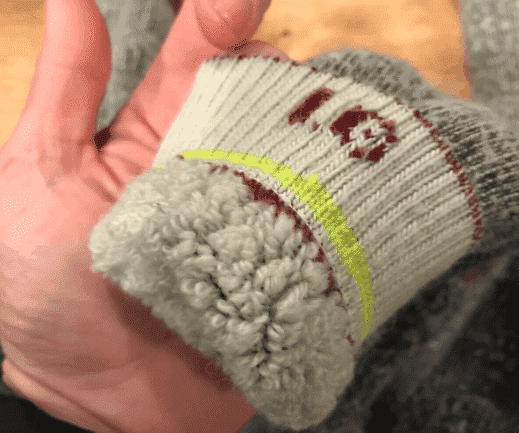Merino Wool is warm in the winter, cool in the summer, and by far the best choice for wet conditions. Wool dries fast and retains warmth when damp, but is merino wool waterproof?
Merino wool is not waterproof, but it is water resistant. Wool is a great base-layer in wet conditions. It maintains its insulating properties, dries fast, and reduces body odors. You can’t go wrong with merino wool socks and base-layers.
Although merino wool isn’t waterproof it does maintain heat when damp. My Icebreaker Merino Wool Tops and Leggings and Smartwool Socks are perfect in cold/wet conditions. It keeps me warm in the winter and cool in the summer, but you can’t expect wool to stay bone dry.
Wool Is Water Resistant Not Waterproof
Wool has long been thought of as “The Wonder Fiber”. It stays warm in the winter, cool in the summer, fights against moisture, smell-resistant, and it’s very durable. Merino wool is far better than cotton, fleece and other synthetic materials.
You can’t say merino wool is waterproof, but it does actively resist moisture absorption. Each and every wool fiber already contains moisture leaving less room for water to soak in.
Wool is able to absorb up to 30% of its weight before it starts to feel wet. This delay is one of the main reasons why it can keep you warm in the rain. You can go longer without feeling the moisture start to soak in.
Wool Wicks Moisture Away From Your Body
Have you ever noticed the honeycomb weave on the inside of synthetic jackets? That’s a way to artificially create space between your body and the coat. These tiny air pockets provide insulation, breathability, and draw moisture away from your body.
Merino wool fibers have a natural crimp that helps wick moisture away from the body. Getting excess moisture off your skin is the key to staying warm in wet environments.
Merino Wool Stays Warm When Damp/Wet
Wool can soak up a lot of moisture before it starts to feel wet. The fancy word for this is “Hygroscopic Insulator”, but it just means wool can absorb moisture from the air. It uses tiny air pockets in the wool and body heat to maintain warmth (like a styrofoam cooler).
This basically means that merino wool will still keep you warm when it’s wet. Anybody that’s worn merino wool socks with trail runners can vouch.
There’s just no way to keep your feet completely dry on long backpacking trips. Your feet will eventually get wet and merino wool socks will keep you comfortable.
I’m addicted to buying Smartwool Socks every time they go on sale. They’re extremely comfortable and keep your feet warm in even the most extreme weather conditions. From the heat of summer to freezing Ohio winters, I wear them all year long.
Antibacterial and Odor Resistant
Every fiber of wool has an oily wax coating called lanolin. Lanolin not only helps repel water during the rainy months, it also fights against bacteria. This cuts down on mold, mildew and odor causing bacteria.
The breathability, moisture management, and antimicrobial properties makes merino wool somewhat smellproof. You can go 3-4 days (sometimes weeks) between wash cycles without getting a funky body odor smell.
Remember The Three Base Layers in Cold Weather
When the weather gets cold/wet you need to focus on the three layers. You have the base layer, insulating layer and shell. Without all three layers you won’t stay warm and dry.
The base-layer moves sweat away from the body. Insulating layer traps heat in the airspace around our body and moves moisture out. Shell layer protects you from wind, cold air and moisture. You can’t effectively fight the elements without all three layers.
Merino wool is by far the best base-layer. Personally, I prefer Icebreaker products, but they can be expensive. The REI-Coop House brand is a great alternative and they have regular sales. Darn Tough Hiking Socks are the most durable, but Smartwool socks are way more comfortable.




